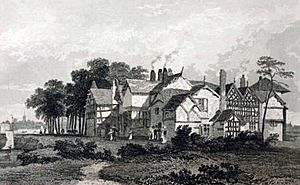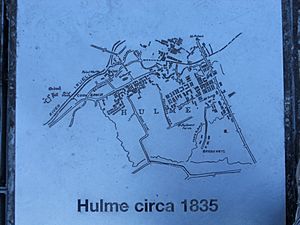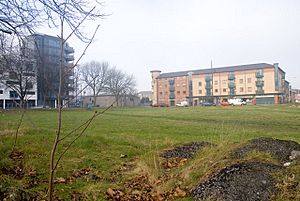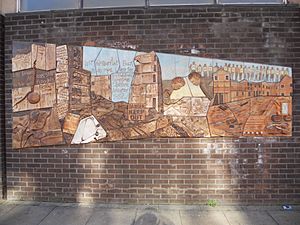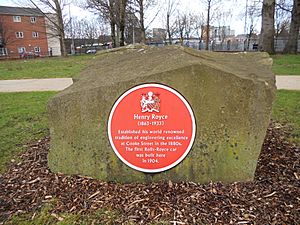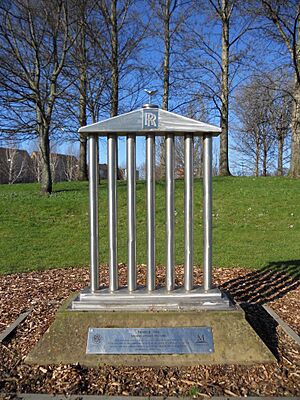Hulme facts for kids
Quick facts for kids Hulme |
|
|---|---|
 The Hulme Arch Bridge, with the Beetham Tower in the background, 2008 |
|
| Area | 2.204 km2 (0.851 sq mi) |
| Population | 16,907 (2011 Census) |
| • Density | 7,671/km2 (19,870/sq mi) |
| OS grid reference | SJ834963 |
| • London | 160 mi (260 km) S |
| Metropolitan borough | |
| Metropolitan county | |
| Region | |
| Country | England |
| Sovereign state | United Kingdom |
| Post town | MANCHESTER |
| Postcode district | M15 |
| Dialling code | 0161 |
| Police | Greater Manchester |
| Fire | Greater Manchester |
| Ambulance | North West |
| EU Parliament | North West England |
| UK Parliament |
|
| Councillors |
|
Hulme (/hjuːm/) is an inner city area and electoral ward in Manchester, England. It's located just south of the city centre. Hulme has a really interesting past, especially linked to factories and industry.
Long ago, Hulme was part of Lancashire. Its name comes from an Old Norse word, holmr, which means a small island or land surrounded by water. This suggests that Norse people might have settled here first, during a time known as the Danelaw.
Contents
Hulme's Story: A Look Back
What's in a Name?
The name Hulme comes from an old Norse word, holmr, which means a small island or land surrounded by water. This makes sense because Hulme is almost surrounded by three rivers: the River Irwell, River Medlock, and Corn Brook. Some historians think that the many Danish names in this part of Manchester show that Danish settlers lived here a long time ago.
Hulme in Early Times
Records from the 1200s mention places like Ouerholm and Noranholm, which were likely early names for parts of Hulme. People with the last name de Hulm or del Hulme also appear in old documents from this time.
In 1310, there's a mention of "the manor of Hulm," which was a large estate near Manchester. Later records from 1322 show that people like Geoffrey de Hulme and John le Ware held land in Hulme.
By the 1400s, maps showed Hulme as a separate community south of the River Medlock. Christopher Saxton's map from 1577 also showed "Holme" where the Medlock and Irwell rivers met. Hulme Hall, a large house, was located near the River Irwell. For a long time, until the 1700s, Hulme was mostly farmland. It was a peaceful, rural area with crops and country life.
Everything changed when the Bridgewater Canal was built. This canal brought cheap coal from mines to Manchester's growing textile factories. This was the start of the Industrial Revolution, and it completely transformed Hulme.
The Industrial Revolution and Big Changes
The Industrial Revolution brought many factories and jobs to Hulme. Coal was brought in by narrow canal boats and then moved by carts. Soon, many cotton mills and a railway line were built in Hulme. Thousands of people moved to the area to work in the busy factories.
The number of people living in Hulme grew by 50 times in the first half of the 1800s! Houses were built very quickly, and there wasn't much space. This led to low-quality homes packed together, surrounded by smoking factory chimneys and railway lines.
By 1844, the situation was so bad that Manchester Borough Council had to stop more houses from being built. However, thousands of these older, crowded homes were still used for many years.
Friedrich Engels, a German writer, described the poor living conditions in areas like "Little Ireland" near Hulme. He wrote about crowded, dirty cottages, streets without proper drains, and lots of rubbish. Hulme also had similar issues, with many homes being in poor condition.
Many Irish immigrants came to live in Hulme and other parts of Manchester during this time.
In 1863, a group of working men from the Hulme Athenaeum club started an association football (soccer) club. This is thought to be one of the first football clubs in Manchester and Lancashire!
New schools were also built in Hulme in the late 1800s, like the one on Vine Street in 1874.
In the early 1900s, transport improved with electric trams replacing horse buses. These trams connected Hulme to other areas like Moss Side and Chorlton-cum-Hardy. Hulme also had two theatres: the Hulme Hippodrome and the BBC Playhouse.
Hulme After World War II
After the Second World War, Britain needed better housing for its growing population. By the 1960s, many old, crowded areas in Hulme were torn down. New buildings were designed in a modern style, including tall tower blocks and "cities in the sky" with flats that had walkways high above the streets.
One famous design was the Hulme Crescents. These were curved blocks of flats with walkways for people, while cars stayed on the ground. The idea was to separate people from traffic and pollution. People moved into these new flats from old homes that didn't have electricity, running water, or indoor toilets.
The Crescents even won design awards and were some of the first council homes in Manchester with central heating. Famous people like Nico and Alain Delon lived there for a while.
However, the Crescents soon had problems. They were poorly built and hard to heat, especially after the 1970s oil crisis made energy expensive. They became cold, damp, and had issues with pests. Safety also became a concern because police didn't patrol the long, dark walkways.
Because of these problems, the Crescents were declared "unfit for purpose" within ten years. In the 1980s and 1990s, many empty flats were taken over by people who didn't have homes, and Hulme became known as a place for artists and musicians.
Hulme Today: A Fresh Start
In the early 1990s, the decision was made to tear down the Hulme Crescents and build new, lower-rise homes. Over £400 million was spent to improve Hulme and the nearby area of Moss Side. Today, Hulme is a popular place to live, with a mix of council and privately owned homes.
Birley Fields Development
One area in Hulme, called Birley Fields, is being developed with new office buildings. Companies like Michelin have offices there. The Manchester Metropolitan University also has plans to build a new campus here, which will include academic buildings and student housing. This project is expected to create more jobs and help the local economy.
Community and Housing
Hulme's reputation has greatly improved. It's now known for its strong community spirit. For example, the Hulme Community Garden Centre is a non-profit group that brings people together through gardening and learning about nature. Work for Change is another place where many community groups and artists work.
Because Hulme is so close to the city centre, it's a popular place for young professionals to live. It's also home to many students from the University of Manchester. The area has local facilities like the Zion Arts Centre, Hulme Community Garden Centre, and Hulme Park. For shopping, there's the Hulme Shopping Centre with an Asda supermarket.
How Hulme is Governed
Hulme has been a part of Manchester since 1838. Today, it is an electoral ward within the city of Manchester. This means it's a specific area that elects people to represent it on the Manchester City Council.
Hulme is also part of the Manchester Central parliamentary area. This area is represented in the UK Parliament by a Member of Parliament (MP). Currently, Lucy Powell is the MP for Manchester Central.

Local Councillors
Hulme is currently represented on the City Council by three councillors: Ekua Bayunu (Green Party), Lee-Ann Igbon (Labour Party), and Annette Wright (Labour Party). These councillors work to improve the local area and represent the people of Hulme.
Hulme's Location and Green Spaces
 |
Salford | Manchester city centre | Manchester city centre |  |
| Old Trafford | Chorlton-on-Medlock | |||
| Whalley Range | Whalley Range | Moss Side |
Hulme is located south of Manchester city centre, separated by the River Medlock. The Bridgewater Canal also runs through Hulme.
Parks and Recreation
Hulme has several green spaces for people to enjoy. These include St George's Park in the northwest and Hulme Park, which is 29 acres large and was created in 2000.
The Hulme Community Garden Centre is a special place run by the community. It helps local people connect through gardening, learning, and volunteering. Hulme also used to have a Unit Four cinema, which opened in 1970.
People and Population
Hulme's Population Over Time
In 1801, Hulme had only 1,677 people. But as the Industrial Revolution grew, so did Hulme's population. By 1831, it had reached 9,624, and by 1841, it was 26,982! The population kept growing, reaching its highest point in 1871 with 74,731 people. After that, the population slowly started to decline.
Religion in Hulme
Hulme has a history of different religious communities.
- Church of England
The Church of St George, Chester Road, Hulme, built in 1826–27, was a beautiful Anglican church with a tall tower. It was once the church for the nearby army barracks and the main church for Hulme. It has since been turned into homes.
St Mary's Church, built in 1856–58, is another former Anglican church with a tall steeple. This church has also been converted into apartments.
The Church of the Ascension was built in 1970 as part of Hulme's redevelopment. Other Anglican churches in Hulme no longer exist.
In 1986, Viraj Mendis, a man from Sri Lanka, sought safety in the Church of the Ascension. He stayed there for two years with the help of the church's leader. In 1989, police entered the church and arrested Mendis, who was then sent back to Sri Lanka.
- Other Churches
Many other types of churches were built in Hulme over the years. The Zion Congregational Chapel, later the Stretford Road Congregational Church, was used for famous events, including a performance by Luciano Pavarotti and filming for the movie Reds.
- Roman Catholic Church
St Wilfrid's Roman Catholic Church is an early work by the famous architect A. W. Pugin. It's a good example of early Gothic Revival style, though its tower was never fully completed.
Industry and Innovation
In the 1800s, Hulme had some small workshops and factories. The Knott Mill Iron Works was a large factory on the banks of the Medlock River. Other big factories were nearby, providing jobs for many people in Hulme.
Rolls-Royce: A Famous Start
In 1884, Henry Royce started a factory at Cooke Street in Hulme, making electrical items. In a small part of his workshop, he built his first three cars. In 1904, Royce met Charles Stewart Rolls at the Midland Hotel in Manchester. They decided to work together and started building their own motor cars.
Hulme was the very first home of their company, Rolls-Royce! Although they later moved their main operations to Derby, the famous Silver Ghost car was designed and first made in Hulme. The Rolls-Royce V-8 engine was also designed here in 1905.
Many places in Hulme remember this important history, like Royce Road, Rolls Crescent, and the Bentley House Estate. In 2007, a sculpture called "Temple 2000," which looks like a Rolls-Royce car grille, was put in Hulme Park to celebrate the old factory site.
Notable People from Hulme
Many interesting people have connections to Hulme:
- Rowland Detrosier, a politician and educator, grew up here in the early 1800s.
- John Foulds (1880–1939), a classical music composer, was born in Hulme.
- Albert Hill won a Victoria Cross medal in the First World War.
- Morrissey, the lead singer of the band the Smiths, spent his childhood in Hulme.
- Jazz trumpeter Kevin Davy lived in Hulme as a student.
- Poet and radio presenter Lemn Sissay spent his early life in Hulme.
- Musician and TV presenter John Robb lives in Hulme.
- Billy Duffy, the guitarist from the band The Cult, grew up here.
- Film critic Mark Kermode lived in Hulme when he was a university student.
- Alfred Garth Jones, a famous illustrator, was born in Hulme in 1872.
- Actor Alan Igbon, known for his role in Boys from the Blackstuff, was born in Hulme.
- Albert Scanlon, a football player for Manchester United and a survivor of the 1958 Munich air disaster, was born in Hulme in 1935.
Images for kids



